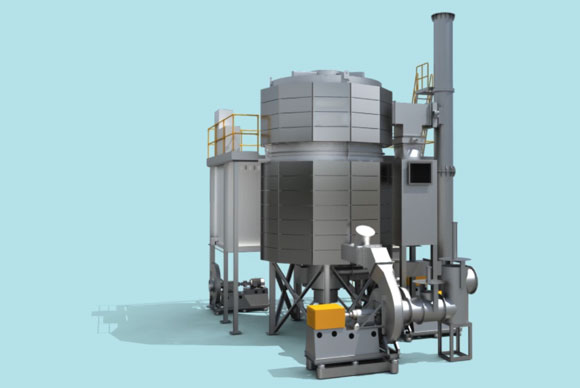How to conduct a feasibility study for a regenerative thermal oxidizer project?
A regenerative thermal oxidizer (RTO) is a widely used air pollution control technology that destroys volatile organic compounds (VOCs) and hazardous air pollutants (HAPs) emitted from industrial processes. Implementing an RTO project can be a significant investment for a company, and therefore, conducting a feasibility study is necessary to determine if the project is viable and cost-effective. This article provides a comprehensive guide on how to conduct a feasibility study for a regenerative thermal oxidizer project.

1. Scope of the project
- Define the purpose and goals of the project
- Determine the expected emissions reduction and compliance requirements
- Identify potential sources of VOCs and HAPs
The scope of the project defines the boundaries and objectives of the feasibility study. It is essential to define the purpose and goals of the project, such as achieving compliance with environmental regulations or improving air quality. The expected emissions reduction and compliance requirements should also be determined since these are the primary drivers for implementing an RTO project. Identifying potential sources of VOCs and HAPs is necessary to estimate the size and capacity of the RTO system required.
2. Technical assessment
- Evaluate the suitability of RTO technology for the process and emissions characteristics
- Analyze the process flow and emissions data to determine RTO size and capacity
- Assess the energy and utility requirements of the RTO system
The technical assessment evaluates the suitability of RTO technology for the process and emissions characteristics. The RTO system’s size and capacity depend on the process flow and emissions data, such as flow rate, temperature, and pollutant concentration. The energy and utility requirements of the RTO system should also be assessed to determine the operating cost and feasibility of the project.
3. Financial analysis
- Estimate the capital and operating costs of the RTO system
- Determine the payback period and return on investment
- Analyze the impact of incentives and tax credits on the project
The financial analysis estimates the capital and operating costs of the RTO system. The capital cost includes the equipment, installation, and engineering costs, while the operating cost includes the energy and maintenance costs. The payback period and return on investment should also be determined to assess the project’s financial viability. The impact of incentives and tax credits, such as grants or tax deductions, should also be analyzed to determine their effect on the project’s financial performance.
4. Risk assessment
- Identify potential risks and uncertainties associated with the project
- Analyze the impact of external factors, such as market conditions and regulatory changes
- Develop a risk management plan to mitigate potential risks
The risk assessment identifies potential risks and uncertainties associated with the project, such as technical, financial, or regulatory risks. The impact of external factors, such as market conditions and regulatory changes, should also be analyzed to determine their effect on the project’s feasibility. Developing a risk management plan is necessary to mitigate potential risks and ensure the project’s success.
結論
Conducting a feasibility study is essential for determining the viability and cost-effectiveness of an RTO project. The scope of the project defines the boundaries and objectives of the study, while the technical assessment evaluates the suitability of RTO technology for the process and emissions characteristics. The financial analysis estimates the project’s costs and returns, while the risk assessment identifies potential risks and uncertainties associated with the project. By following these steps, companies can make informed decisions on whether to implement an RTO project.
公司簡介
We are a high-tech equipment manufacturing company specializing in the comprehensive control of volatile organic compound (VOC) emissions and carbon reduction energy-saving technology. Our core technologies include thermal energy, combustion, sealing, and self-control. We have the capability for temperature field simulation, airflow simulation modeling, ceramic heat storage material performance, molecular sieve adsorbent material selection, and VOC high-temperature incineration oxidation testing.
Our advantages lie in having a RTO technology research and development center and a waste gas carbon reduction engineering technology center in Xi’an, as well as a 30,000 square meter production base in Yangling. We are a leading manufacturer in the global RTO equipment and molecular sieve rotary wheel equipment industry. Our core technical team comes from the Aerospace Liquid Rocket Engine Research Institute (Aerospace Sixth Institute). With over 360 employees, including more than 60 R&D technology backbone members, we have 3 senior engineers at the researcher level, 6 senior engineers, and 80 thermodynamics doctors.
核心產品
Our core products are the rotating valve regenerative thermal oxidizer (RTO) and molecular sieve adsorption concentration rotary wheel. Combined with our expertise in environmental protection and thermal energy system engineering, we provide customers with comprehensive solutions for industrial waste gas control and carbon reduction through heat energy utilization.

認證、專利和榮譽
- 智慧財產權管理系統認證
- 品質管理系統認證
- 環境管理系統認證
- 建築業企業資質
- 高新技術企業
- Patent for Rotary Valve of Rotary Heat Storage Oxidation Furnace
- Patent for Rotary Heat Incineration Equipment
- 盤式沸石轉輪專利

選擇合適的 RTO 設備
- Assessment and Consultation:
- Initial consultation
- Site inspection
- Demand analysis
- Design and Solution Development:
- Plan design
- Simulation and modeling
- Solution review
- Production and Manufacturing:
- Customized production
- Quality control
- Factory testing
- Installation and Commissioning:
- On-site installation
- Commissioning and operation
- Training services
- After-sales Support:
- Regular maintenance
- Technical support
- Spare parts supply
We provide one-stop solutions and have a professional team to tailor RTO solutions for our customers. Each point is explained in detail.
作者:米婭
